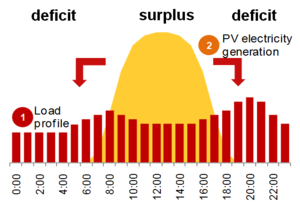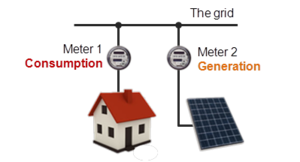Knowledge fuels change
For over a decade, Energypedia has shared free, reliable energy expertise with the world.
We’re now facing a serious funding gap.
Help keep this platform alive — your donation, big or small, truly matters!
Thank you for your support
Net Metering
Overview
Net-metering is ...
- ... a regulatory model that allows electricity producers to "store“ surplus electricity from variable energy sources in the national/regional/local grid, and use the "stored“ electricity to balance out deficit, allowing households/investors to meet their own electricity demand with their own production[1].
- ... a system, in which the active current / electricity generated by consumers in decentralized micro- and mini- generators, is offset with the metered consumption[2]
How does net metering work?
Net metering means that both the electricity produced and consumed by a household or investor is measured. The prerequisite for net metering is economic viability of the net-metered electricity source compared to the grid price. This is also referred to as grid parity, a situation where it is cheaper to produce one's own electricity than to buy it from the national utility.
The basic elements of net metering are:
- Electricity generation: electricity is usually generated by a small renewable energy system, permitting households or other small-scale investors to produce their own electricity.
- Tailored to match consumption: electricity generation should be sized to match consumption.[3]
- Grid connection: the net metering system is integrated with the grid. Surplus electricity produced is fed into the grid (e.g. during the day with solar PV), while any deficit in production is compensated by electricity taken from the grid (e.g. during the night with solar PV)[4].
- Metering: measuring the electricity produced and consumed can be done in two ways:
Using one, reversible meter that measures both the electricity consumed and produced.
Using two meters - one measuring production, the other consumption. In many cases, this dual-metering system is preferred since it allows for production and consumption to take place in different areas, and for the application of different rates for production and consumption.[5]
- Billing: billing is based on the net amount of electricity consumed per billing period - in other words, the difference between the amount of electricity consumed and the amount produced. If a household produces more electricity than it consumes, the surplus can usually be carried over (many times with a validity time limit attached), or be given to the utility without any compensation.
How and Where Has Net Metering Been Applied
Net metering has been successfully implemented in both developed and developing countries.
While the ways in which these countries have gone about impelenting the regulation differs according to the context, several elements are recurring:
- Net metering is usually focused on smaller system sizes, in most cases with a set limit in terms of the % contribution of net metered systems to the overall energy mix.
- There are different technologies included in each country's regulations, although solar PV and wind usually feature in almost all settings since variable energy sources benefit considerably from net metering.
The following table provides an overview of countries where net metering policies are currently in use:[6]
|
Country |
Implemented |
Energy sources |
Size limits |
Contribution limits |
Source |
HIGH INCOME COUNTRIES | |||||
|
Barbados |
2013 |
Wind, solar PV or hybrid(wind/solar) |
150 kW max per system, to a total of 7,000 kW |
? |
|
|
Belgium |
2004 |
All Renewable Energy sources |
? |
? |
|
|
Denmark |
2010 |
Wind, Solar, Biomass |
6 kW |
? |
|
|
Italy |
2006 |
All Renewable Energy sources |
200 kW |
? |
|
|
Malta |
2010 |
Solar PV |
3 kW (hh) 100 kW (business) |
7.5 MW/year |
|
UPPER-MIDDLE INCOME COUNTRIES | |||||
|
Brazil |
2012 |
Hydraulic, Solar, Wind, Biomass, Cogeneration |
≤ 1MW |
||
|
Dominican Republic |
2011 |
|
25 kW (hh); 1 MW (business) |
|
|
|
Jordan |
2010 |
All Renewable Energy Sources |
? |
? |
|
|
Tunisia |
2009 |
Solar PV, ? |
1 - 2 kW |
? |
|
LOWER-MIDDLE INCOME COUNTRIES | |||||
|
Guatemala |
Solar PV, Wind, Biomass, Hydro, Geothermal | 5 MW | ? | NARUC | |
|
Pakistan |
2006 | All Renewable Energy policies | 1 MW | ? | GoP |
|
Philippines |
Wind, solar PV, Biomass, Biogas | ? | ? | EEAS | |
|
Sri Lanka |
2009 | All Renewable Energy Sources | <= consumption | ? | The Island |
Apart from the abovementioned countries, the following countries also have functioning net metering legislation: Canada, Japan, Lebanon, Mexico, Panama, Portugal, Singapore, South Korea, Uruguay, USA.
Net metering is also being developed and piloted in the following low-income countries:
|
Country |
Status |
|
Ghana |
Net-metering is being piloted by private sector, although no specific regulation exists yet[5]. |
|
Kenya |
Net-metering forms part of draft energy policy, and 2 pilot systems are feeding into the grid. Regulations are being developed[5] |
|
Senegal |
? |
Pro's and Con's of Net Metering
There are two cases to be made for applying net-metering in developing countries: the economic case, and the regulatory/policy case[5].
The economic case is primarily built on the fact that certain renewable energy generation costs have reached, or will shortly reach, grid parity in many developing countries.
Grid parity can be defined in two ways[7]:
|
- The excellent renewable energy resource regimes in many developing countries (e.g. solar radiation).
- The dramatically falling costs of certain renewable energy technologies, especially solar PV panels.
- The high and often fluctuating electricity tariffs (e.g. driven by the high reliance on thermal / diesel- based power generation with high and fluctuating variable costs).
- Growing maturity of RE technology and business models
For the energy authorities in developing countries, the regulatory/policy case is based on the following reasons:
- Net-metering allows for the production of additional electricity, freeing up other generation resources. For utilities, net metering is therefore in effect similar to demand side management / energy efficiency measures.
- Decentralized generation and modern inverters can assist in stabilizing the grid.
- Net-metering is (should be) light-handed regulation with low transaction costs.
- There are the standard benefits related to increased renewable energy generation, such as savings on fuel imports, job creation, carbon financing options, etc.
- Net-metering is also complimentary to feed-in tariffs (FiTs) (a regulatory/policy tool being used in an increasing number of countries), as it targets system sizes usually not targetted by FiTs.
- Utilities stand to lose revenue as consumption from the grid is replaced by self-generated power. Furthermore, utilities are de facto providing a service by "storing" electricity in the grid (for variable RE also balancing!), and could therefore make the case for a compensation.
- The increased use of variable power sources, such as solar PV or wind, can threaten grid stability. Net metering will therefore have to feature in overall power system planning.
- Both technical and regulatory capacity is needed to ensure that net-metering systems are installed correctly, that distribution networks are able to accommodate net-metered systems and that the appropriate regulation is developed and implemented.
Success Factors for Net Metering
- Policy: net metering should form part of overall policy and planning, providing clear market signals.The policy should therefore be detailed, transparent and publicly available.
- Regulation: energy regulations must make provision for net metering, clearly setting out the energy sources & technologies included, the system capacity limits, standards, electricity rates, application process, overall contribution limits (if any) as well as other provisions, exemptions and any other modality required to make it work in practice.
- Agreement with utilities: electricity utilities that will be affected by net metering should agree to accept and "buy" electricity generated by net metered systems, as this will affect their overall performance and possibly grid stability. The utility will most likely also be in charge of inspecting and approving net metered systems.
- Technical expertise: technical capacity is needed, both at regulatory and utility level, to ensure the proper application and management of net metering standards. At the private sector level, it is also important that technicians have the technical capacity to install and service net metered systems.
- Regulatory capacity: regulatory authorities need to have the capacity to ensure that net metering policies and regulations are not only well developed, but also properly implemented.
GIZ Experience with Net Metering
- Brazil: The GIZ Energy Programme, “Renewable Energy Sources and Energy Efficiency”, is running from 2013 to 2015[8]. Among other activities, GIZ is assisting the Brazilian Energy Regulatory Authority (ANEEL), local governmental institutions and other stakeholders to develop and implement net-metering policy[3]. Net metering legislation was enacted in April 2012, covering all renewable energy systems up to 1 MW[9].
- Kenya: Through the Project Development Programme (PDP) and a development partnership (develoPPP), GIZ has been supporting the Kenyan authorities in developing net metering legislation and policy. Net metering has now been included in draft energy policy, forming part of wider energy sector reforms taking place. Two pilot projects feeding solar PV into the national grid have been launched: a 60 kW installation at the SOS Children’s Village in Mombasa; and a 515 kW system on the roof of the UNEP offices[5]. The EU Energy Initiative Partnership Dialogue Facility (EUEI PDF) is also providing further support to formulate net-metering regulation in the country through a project under the Renewable Energy Cooperation Programme (RECP).
- Mexico: GIZ is providing energy sector technical assistance to Mexico as part of the “Sustainable Energy Mexico” program[10]. Net metering has been possible in the country since 2007, with capacity limits set at 30kW and 500kW respectively, depending on whether a net-metered system is classified as small- or medium-scale[3].
- Morocco: The “Promotion of Renewable Energy and Energy Efficiency” project, implemented by GIZ, has as one of its components the assessment of the potential for grid-connected solar PV in Morocco[11]. The assessment has shown that Morocco will achieve grid-parity for all customer categories by 2013. GIZ is also developing a “million roofs program” proposal, which is dependent on net metering. While there are currently no specific net metering regulations in place, a law published in 2010 makes it possible to connect medium- and high-voltage renewable energy based systems to the grid[3].
Further Information
References
- ↑ Database of State Incentives for Renewables & Efficiency (DSIRE) http://www.dsireusa.org/solar/solarpolicyguide/?id=17
- ↑ ANEEL 2012. Regulierung Nr. 482 vom 17. April 2012 der Nationalen fckLREnergieagentur – ANEEL (Brazil)
- ↑ 3.0 3.1 3.2 3.3 3.4 Project Development Program (PDP). 2011. "Grid connection of solar PV: Technical and economical assessment of net-metering in Kenya". GIZ, Federal Ministry of Economics & Technology.
- ↑ The public utilities commission of Ohio.http://www.puco.ohio.gov/puco/index.cfm/consumer-information/consumer-topics/generating-your-own-electricity-net-metering/
- ↑ 5.0 5.1 5.2 5.3 5.4 Franz. M. 2012. "Net metering for small RE - the next big show in town? Background and evidence from Kenya and Ghana." Presented at the GIZ Fachverbund Energy Africa, Dakar, Senegal.
- ↑ REN21, 2012. "Renewables 2012 Global Status Report", REN21 Secretariat, Paris
- ↑ Farrell, J. 2012. "Solar Grid Parity 101". http://www.ilsr.org/solar-grid-parity-101/
- ↑ GIZ, "Energy programme for Brazil" http://www.giz.de/de/weltweit/12565.html
- ↑ Figueiredo, R. 2012. "Brazil's attempt at distributed generation: will net metering work?" Renewable Energy World. http://www.renewableenergyworld.com/rea/news/article/2012/07/brazils-attempt-at-distributed-generation-will-net-metering-work
- ↑ GIZ. "Sustainable Energy in Mexico". http://www.giz.de/themen/en/27816.htm
- ↑ GIZ. 2012. "The promotion of renewable energy and energy efficiency - the 'PEREN' project". http://www.giz.de/Themen/de/dokumente/giz2012-renewable-energy-peren-en.pdf





















